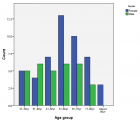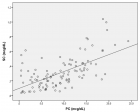Table of Contents
Creatine Supplementation and Akt/mTOR Pathway: Unraveling the Connection for Optimal Muscle Performance
Published on: 14th June, 2023
This review paper investigates the relationship between creatine supplementation and the Akt/mTOR pathway, focusing on their impact on muscle performance. The Akt/mTOR pathway is a crucial signaling pathway that regulates muscle protein synthesis and hypertrophy in response to growth factors, nutrients, and mechanical stimuli. Recent evidence suggests that creatine supplementation can influence anabolic signaling pathways, including the phosphorylation of p70S6K, a downstream target of mTOR, leading to enhanced activation of the Akt/mTOR pathway. Additionally, creatine supplementation has been shown to increase intramuscular creatine and phosphocreatine levels, improving ATP availability during exercise and enhancing high-intensity muscle contractions. Understanding the complex regulatory mechanisms of the Akt/mTOR pathway is vital for optimizing muscle performance, as dysregulated signaling can hinder muscle protein synthesis and hypertrophic responses. This review highlights the potential of creatine supplementation to modulate the Akt/mTOR pathway, offering insights into its mechanisms and implications for muscle performance enhancement. By unraveling this connection, researchers and practitioners can develop targeted strategies to maximize muscle performance and promote adaptive responses in various exercise and athletic contexts.
Collegiate athlete with unilateral swollen arm after exercise
Published on: 8th June, 2023
A collegiate football player presented to the athletic training room with the complaint of intermittent left upper extremity swelling. Deep vein thromboses as well as abnormalities of the cervical spine were ruled out initially. He was referred to a vascular surgeon and diagnosed with McCleery Syndrome after evaluation of the thoracic outlet with dynamic ultrasound testing. He was treated surgically for decompression of his venous thoracic outlet syndrome and has since made a full recovery.
The lateralization pattern has an influence on the severity of ankle sprains
Published on: 28th April, 2023
Study design: Descriptive study.Background: Many risk factors contributing to ankle sprains have been studied in medical literature with coordination and balance being two of the major endogenous factors described. These are influenced by lateralization – a developmental and adaptive ability determined by the asymmetrical construction of the human brain, with cross-laterality referring to mixed limb dominance.Objectives: To determine whether cross lateralization is a risk factor for the severity of ligamentous injuries in ankle sprains since no data is yet available on such correlation. Methods: Two hundred forty-four patients with acute ankle sprains (136 men and 108 women) were prospectively evaluated between April 2006 and March 2009. The mean age was 30 (ranging from 18 to 76). Clinical and ultrasonographic examinations were performed on the study subjects. Laterality was then assessed by the Coren questionnaire and the AOFAS score was calculated. Patients with syndesmotic injuries and fractures were excluded from the study. Those qualified were divided into straight and crossed groups, according to their laterality type. Results: One hundred forty-four patients displayed straight lateralization, while cross-laterality was found in 100 subjects. Patients in the crossed group experienced more multi-ligamentous injuries than those in the straight group (p = 0.02). Following trauma, a higher AOFAS score was attributed to subjects that displayed a straight lateralization pattern, in comparison to subjects presenting with crossed laterality (p = 0.04).Conclusion: Crossed lateralization is associated with higher severity of ligament injuries in ankle sprains and may be considered a risk factor for calcaneofibular ligament injuries.
Anatomy and biomechanics of the rat knee ligaments
Published on: 27th April, 2023
In this study, the authors systematically examined the anatomical and biomechanical properties of the ligaments in the normal rat knee. These biomechanical data will facilitate the use of the rat knee model for future studies of knee ligament injury, repair, and reconstruction. Fifty-six fresh cadaver male Sprague-Dawley rats, aged 16 weeks, were used for this study, with 48 rats for biomechanical testing and 8 for micro-CT and histological evaluation. Our findings suggest that the gross anatomy of the rat knee joint and ligaments is very similar to humans despite some minor differences and features unique to the rat knee. The patella tendon and ACL are the two strongest soft tissue structures in the rat knee joint, with the highest failure force and stiffness, and both play a role in the anterior stability of the knee. In comparison, the failure force and stiffness of the LCL is half of the MCL, suggesting that other structures, such as the popliteal tendon, may play some role in lateral knee stabilization besides the LCL. In addition, our data suggest that anterior knee stability was improved after ACL reconstruction, but was not fully restored to intact ACL function. In conclusion, our study indicates the anatomical and biomechanical properties of the knee joint and ligaments of rat knees. Then we could confirm a reproducible and realistic rat model of knee ligaments like the clinical cases, and provide a basis for the study of knee ligament biology that simulates techniques used in humans.
Effects of exercise on wall shear stress in male and female patients with coronary heart disease
Published on: 21st April, 2023
Coronary heart disease (CHD) seriously endangers human health, and there are obvious gender differences in incidence rate and prognosis, which are related to the evident differences in anatomical structure, physiological characteristics, and wall shear stress between males and females. In recent years, cardiac rehabilitation has been proven to be safe and effective in controlling the progression and improving the prognosis of CHD. Thereinto, exercise therapy is the central link of cardiac rehabilitation. Exercise can significantly affect vascular endothelial function by regulating wall shear stress. Based on previous research, this paper will briefly review the influence of exercise on wall shear stress in male and female patients with CHD, in order to provide a reference for formulating personalized cardiac rehabilitation programs and further improve the prognosis of CHD.

HSPI: We're glad you're here. Please click "create a new Query" if you are a new visitor to our website and need further information from us.
If you are already a member of our network and need to keep track of any developments regarding a question you have already submitted, click "take me to my Query."



















































































































































